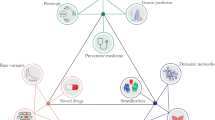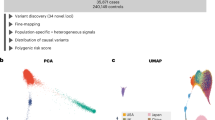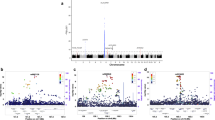Abstract
Individuals with Behçet's disease suffer from episodic inflammation often affecting the orogenital mucosa, skin and eyes. To discover new susceptibility loci for Behçet's disease, we performed a genome-wide association study (GWAS) of 779,465 SNPs with imputed genotypes in 1,209 Turkish individuals with Behçet's disease and 1,278 controls. We identified new associations at CCR1, STAT4 and KLRC4. Additionally, two SNPs in ERAP1, encoding ERAP1 p.Asp575Asn and p.Arg725Gln alterations, recessively conferred disease risk. These findings were replicated in 1,468 independent Turkish and/or 1,352 Japanese samples (combined meta-analysis P < 2 × 10−9). We also found evidence for interaction between HLA-B*51 and ERAP1 (P = 9 × 10−4). The CCR1 and STAT4 variants were associated with gene expression differences. Three risk loci shared with ankylosing spondylitis and psoriasis (the MHC class I region, ERAP1 and IL23R and the MHC class I–ERAP1 interaction), as well as two loci shared with inflammatory bowel disease (IL23R and IL10) implicate shared pathogenic pathways in the spondyloarthritides and Behçet's disease.
This is a preview of subscription content, access via your institution
Access options
Subscribe to this journal
Receive 12 print issues and online access
$209.00 per year
only $17.42 per issue
Buy this article
- Purchase on Springer Link
- Instant access to full article PDF
Prices may be subject to local taxes which are calculated during checkout




Similar content being viewed by others
References
Sakane, T., Takeno, M., Suzuki, N. & Inaba, G. Behçet's disease. N. Engl. J. Med. 341, 1284–1291 (1999).
Yazici, H., Fresko, I. & Yurdakul, S. Behçet's syndrome: disease manifestations, management, and advances in treatment. Nat. Clin. Pract. Rheumatol. 3, 148–155 (2007).
Ono, S., Aoki, K., Sugiura, S., Nakayama, E. & Itakura, K. Letter: HL-A5 and Behçet's disease. Lancet 2, 1383–1384 (1973).
de Menthon, M., Lavalley, M.P., Maldini, C., Guillevin, L. & Mahr, A. HLA-B51/B5 and the risk of Behçet's disease: a systematic review and meta-analysis of case-control genetic association studies. Arthritis Rheum. 61, 1287–1296 (2009).
Gül, A. & Ohno, S. HLA-B*51 and Behçet disease. Ocul. Immunol. Inflamm. 20, 37–43 (2012).
Remmers, E.F. et al. Genome-wide association study identifies variants in the MHC class I, IL10, and IL23R-IL12RB2 regions associated with Behçet's disease. Nat. Genet. 42, 698–702 (2010).
Mizuki, N. et al. Genome-wide association studies identify IL23R-IL12RB2 and IL10 as Behçet's disease susceptibility loci. Nat. Genet. 42, 703–706 (2010).
Moll, J.M., Haslock, I., Macrae, I.F. & Wright, V. Associations between ankylosing spondylitis, psoriatic arthritis, Reiter's disease, the intestinal arthropathies, and Behçet's syndrome. Medicine (Baltimore) 53, 343–364 (1974).
Chang, H.K. et al. The comparison between Behçet's disease and spondyloarthritides: does Behçet's disease belong to the spondyloarthropathy complex? J. Korean Med. Sci. 17, 524–529 (2002).
Yazici, H., Tuzlaci, M. & Yurdakul, S. A controlled survey of sacroiliitis in Behçet's disease. Ann. Rheum. Dis. 40, 558–559 (1981).
Olivieri, I., Salvarani, C. & Cantini, F. Is Behçet's disease part of the spondyloarthritis complex? J. Rheumatol. 24, 1870–1872 (1997).
Burton, P.R. et al. Association scan of 14,500 nonsynonymous SNPs in four diseases identifies autoimmunity variants. Nat. Genet. 39, 1329–1337 (2007).
Duerr, R.H. et al. A genome-wide association study identifies IL23R as an inflammatory bowel disease gene. Science 314, 1461–1463 (2006).
Nair, R.P. et al. Genome-wide scan reveals association of psoriasis with IL-23 and NF-κB pathways. Nat. Genet. 41, 199–204 (2009).
Ohno, S. et al. Efficacy, safety, and pharmacokinetics of multiple administration of infliximab in Behçet's disease with refractory uveoretinitis. J. Rheumatol. 31, 1362–1368 (2004).
Dougados, M. & Baeten, D. Spondyloarthritis. Lancet 377, 2127–2137 (2011).
Franke, A. et al. Genome-wide meta-analysis increases to 71 the number of confirmed Crohn's disease susceptibility loci. Nat. Genet. 42, 1118–1125 (2010).
Anderson, C.A. et al. Meta-analysis identifies 29 additional ulcerative colitis risk loci, increasing the number of confirmed associations to 47. Nat. Genet. 43, 246–252 (2011).
International Study Group for Behçet's Disease. Criteria for diagnosis of Behçet's disease. Lancet 335, 1078–1080 (1990).
Haroon, N. & Inman, R.D. Endoplasmic reticulum aminopeptidases: biology and pathogenic potential. Nat. Rev. Rheumatol. 6, 461–467 (2010).
Sun, L.D. et al. Association analyses identify six new psoriasis susceptibility loci in the Chinese population. Nat. Genet. 42, 1005–1009 (2010).
Strange, A. et al. A genome-wide association study identifies new psoriasis susceptibility loci and an interaction between HLA-C and ERAP1. Nat. Genet. 42, 985–990 (2010).
Evans, D.M. et al. Interaction between ERAP1 and HLA-B27 in ankylosing spondylitis implicates peptide handling in the mechanism for HLA-B27 in disease susceptibility. Nat. Genet. 43, 761–767 (2011).
Kochan, G. et al. Crystal structures of the endoplasmic reticulum aminopeptidase-1 (ERAP1) reveal the molecular basis for N-terminal peptide trimming. Proc. Natl. Acad. Sci. USA 108, 7745–7750 (2011).
York, I.A., Brehm, M.A., Zendzian, S., Towne, C.F. & Rock, K.L. Endoplasmic reticulum aminopeptidase 1 (ERAP1) trims MHC class I–presented peptides in vivo and plays an important role in immunodominance. Proc. Natl. Acad. Sci. USA 103, 9202–9207 (2006).
Gebreselassie, D., Spiegel, H. & Vukmanovic, S. Sampling of major histocompatibility complex class I–associated peptidome suggests relatively looser global association of HLA-B*5101 with peptides. Hum. Immunol. 67, 894–906 (2006).
Hayashi, T. et al. Identification of the NKG2D haplotypes associated with natural cytotoxic activity of peripheral blood lymphocytes and cancer immunosurveillance. Cancer Res. 66, 563–570 (2006).
Bauer, S. et al. Activation of NK cells and T cells by NKG2D, a receptor for stress-inducible MICA. Science 285, 727–729 (1999).
Raulet, D.H. Roles of the NKG2D immunoreceptor and its ligands. Nat. Rev. Immunol. 3, 781–790 (2003).
Karasneh, J., Gül, A., Ollier, W.E., Silman, A.J. & Worthington, J. Whole-genome screening for susceptibility genes in multicase families with Behçet's disease. Arthritis Rheum. 52, 1836–1842 (2005).
Zeller, T. et al. Genetics and beyond—the transcriptome of human monocytes and disease susceptibility. PLoS ONE 5, e10693 (2010).
Remmers, E.F. et al. STAT4 and the risk of rheumatoid arthritis and systemic lupus erythematosus. N. Engl. J. Med. 357, 977–986 (2007).
Abelson, A.K. et al. STAT4 associates with systemic lupus erythematosus through two independent effects that correlate with gene expression and act additively with IRF5 to increase risk. Ann. Rheum. Dis. 68, 1746–1753 (2009).
Zollner, S. & Pritchard, J.K. Overcoming the winner's curse: estimating penetrance parameters from case-control data. Am. J. Hum. Genet. 80, 605–615 (2007).
Livneh, A. et al. Criteria for the diagnosis of familial Mediterranean fever. Arthritis Rheum. 40, 1879–1885 (1997).
Stranger, B.E. et al. Relative impact of nucleotide and copy number variation on gene expression phenotypes. Science 315, 848–853 (2007).
Niu, N. et al. Radiation pharmacogenomics: a genome-wide association approach to identify radiation response biomarkers using human lymphoblastoid cell lines. Genome Res. 20, 1482–1492 (2010).
Acknowledgements
This research was supported by the Intramural Research Programs of the National Human Genome Research Institute, the National Institute of Arthritis and Musculoskeletal and Skin Diseases, and the Center for Human Immunology, Autoimmunity and Inflammation of the US National Institutes of Health, and by the Istanbul University Research Fund, the Research on Specific Disease of the Health Science Research Grants from the Japanese Ministry of Health, Labor, and Welfare, and the Japan Rheumatism Foundation. We thank A. Wilson for helpful comments on this manuscript.
Author information
Authors and Affiliations
Contributions
The study was designed by Y. Kirino, G.B., A.G., M.J.O., E.F.R. and D.L.K. Analysis was carried out by Y. Kirino, G.B., Y. Kim, A.M., A.G., E.F.R. and D.L.K. Sample procurement and data generation were performed by Y. Kirino, G.B., Y.I., N.M., I.T.-T., E.S., Y.O., F.S.S., B.E., H.I., Z.E., A.C., N.A., D.U., C.S., A.U., M.T., Y. Kim, G.M.W., M.J.O., A.M., A.G., E.F.R. and D.L.K. The manuscript was written by Y. Kirino, G.B., Y. Kim, M.J.O., A.G., E.F.R. and D.L.K. All authors read and approved the final version of the manuscript.
Corresponding authors
Ethics declarations
Competing interests
The authors declare no competing financial interests.
Supplementary information
Supplementary Text and Figures
Supplementary Figure 1 and Supplementary Tables 1–6 (PDF 179 kb)
Rights and permissions
About this article
Cite this article
Kirino, Y., Bertsias, G., Ishigatsubo, Y. et al. Genome-wide association analysis identifies new susceptibility loci for Behçet's disease and epistasis between HLA-B*51 and ERAP1. Nat Genet 45, 202–207 (2013). https://doi.org/10.1038/ng.2520
Received:
Accepted:
Published:
Issue Date:
DOI: https://doi.org/10.1038/ng.2520
This article is cited by
-
Behçet’s Disease as a Canker Sore: MHC-I-Opathy Versus Behcet’s Spectrum Disorders
Current Oral Health Reports (2024)
-
The roles of immune cells in Behçet’s disease
Advances in Rheumatology (2023)
-
Evaluation of HLA-B51 frequency and its relationship with clinical findings in patients with Behçet’s disease: 4-year analysis in a single center
Egyptian Rheumatology and Rehabilitation (2023)
-
Behçet’s syndrome: recent advances to aid diagnosis
Clinical and Experimental Medicine (2023)
-
Transcriptome analysis of immune cells from Behçet’s syndrome patients: the importance of IL-17-producing cells and antigen-presenting cells in the pathogenesis of Behçet’s syndrome
Arthritis Research & Therapy (2022)



